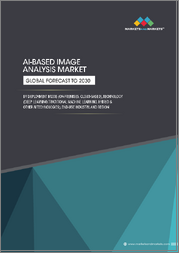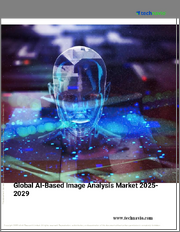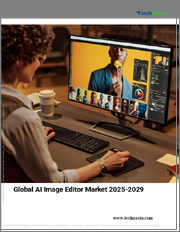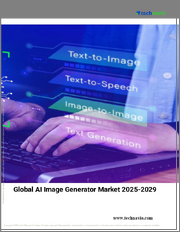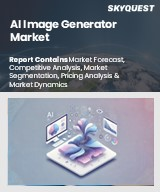
|
시장보고서
상품코드
1803144
세계의 AI 피부 노화 예측 시장 예측(-2032년) : 구성요소별, 전개 방식별, 유통 채널별, 기술별, 용도별, 지역별 분석AI Skin Aging Prediction Market Forecasts to 2032 - Global Analysis By Component (Software, Hardware and Services), Deployment Mode (Cloud-Based, On-Premises and Hybrid), Distribution Channel, Technology, Application and By Geography |
||||||
Stratistics MRC에 따르면 세계의 AI 피부 노화 예측 시장은 2025년에 17억 달러를 차지하고, 예측 기간 동안 CAGR 16.5%로 성장하여 2032년에는 52억 달러에 달할 것으로 예측됩니다.
AI 피부 노화 예측은 현재 피부 상태를 평가하고 미래의 노화 패턴을 예측하기 위해 머신러닝, 딥러닝 등 인공지능 기술을 사용하여 피부 이미지와 데이터를 분석하는 것을 말합니다. 주름, 잔주름, 색소침착, 탄력, 피부결 등의 요소를 처리함으로써 AI 모델은 개인의 피부가 시간이 지남에 따라 어떻게 노화되는지에 대한 개인화된 인사이트를 제공할 수 있습니다. 이 기술은 피부과학적 지식, 생체 데이터, 자외선 노출 및 생활습관 등 환경적 영향을 통합합니다. 스킨케어, 화장품, 피부과에서 예방관리, 맞춤형 치료, 제품 추천에 적용이 진행되고 있습니다.
맞춤형 스킨케어 솔루션에 대한 수요 증가
소비자들은 주름, 색소침착, 탄력 등 자신만의 고민에 맞는 맞춤형 치료를 원하고 있습니다. AI를 활용한 피부 노화 예측 도구는 얼굴 이미지와 생활습관 데이터를 분석하여 정확한 인사이트를 제공하고, 치료 효과를 향상시킵니다. 이러한 개인화는 고객 만족도와 브랜드 충성도를 높이고, 더 넓은 보급을 촉진합니다. 스킨케어 기업들은 AI를 활용해 제품을 차별화하고, 진화하는 소비자 취향에 대응하기 위해 AI를 활용하고 있습니다. 그 결과, 시장은 가속적으로 혁신과 확장을 거듭하고 있습니다.
데이터 프라이버시 및 보안에 대한 우려
얼굴 이미지와 건강 정보를 포함한 민감한 개인 데이터는 악용 및 무단 액세스의 위험을 높입니다. GDPR과 HIPAA와 같은 엄격한 데이터 보호 규정은 이 분야에서 사업을 운영하는 기업들에게 컴플라이언스 이슈가 되고 있습니다. 데이터 유출을 우려해 정확한 예측에 필요한 개인 정보 공유를 주저하는 개인. 데이터 수집, 저장, 사용 방식에 대한 투명성이 제한적이기 때문에 사용자의 신뢰는 더욱 떨어집니다. 이러한 문제들은 시장 성장을 둔화시키고 AI 피부 노화 솔루션의 광범위한 도입을 제한하고 있습니다.
컴퓨터 비전과 딥러닝의 발전
이러한 기술을 활용한 알고리즘은 사람의 눈으로는 알아채지 못하는 피부 질감, 색소침착, 탄력의 미묘한 변화를 식별할 수 있습니다. 방대한 데이터세트로 딥러닝 모델을 훈련시켜 나이 진행 시뮬레이션의 정확도를 높이고, 맞춤형 스킨케어 제안이 가능해집니다. 고급 이미징 기법을 통해 예측 프로세스를 가속화하면서 신뢰성을 향상시켜 AI 기반 솔루션에 대한 소비자의 신뢰를 강화합니다. 모바일 앱 및 스마트 기기와의 통합을 통해 접근성과 참여도를 높일 수 있습니다. 이러한 기술 혁신의 축적은 채용 확대, 시장 확대, 지속적인 성장을 견인하고 있습니다.
저개발 지역의 낮은 보급률
스마트폰, 초고속 인터넷, 고급 이미지 처리 장비에 대한 접근이 제한되어 있어 AI 기반 도구의 사용성이 떨어지고 있습니다. 경제성 문제는 소비자들이 프리미엄 스킨케어 기술에 투자하는 것을 방해합니다. 이러한 지역에서는 의료 시스템이 취약하기 때문에 피부 건강 모니터링을 위한 AI 솔루션의 통합이 더욱 제한됩니다. 숙련된 전문가의 부재와 낮은 디지털 리터러시도 채용을 늦추고 있습니다. 전반적으로 이러한 장벽은 불평등한 시장 침투를 초래하고 세계 확장을 방해하고 있습니다.
COVID-19의 영향
COVID-19 사태는 AI 피부 노화 예측 시장에 다양한 영향을 미쳤습니다. 한편으로는 공급망 혼란, 임상 방문 감소, 피부과 연구 프로젝트 지연으로 인해 시장 성장이 둔화되었습니다. 많은 화장품 및 스킨케어 회사들이 일시적인 운영 중단에 직면하여 AI 기반 솔루션의 채택이 제한되었습니다. 한편, 디지털 헬스케어와 가상 진료로의 전환은 AI를 탑재한 피부 분석 도구에 대한 관심을 높였습니다. 개인 건강, 셀프 케어, 온라인 스킨케어 플랫폼에 대한 소비자의 관심이 높아지면서 피부 노화 예측 기술 도입이 가속화되고 있습니다.
예측 기간 동안 소프트웨어 분야가 가장 클 것으로 예상됩니다.
소프트웨어 분야는 피부 상태를 정밀하게 분석하는 고급 알고리즘으로 인해 예측 기간 동안 가장 큰 시장 점유율을 차지할 것으로 예상됩니다. 이를 통해 개인화된 스킨케어 추천이 가능해져 소비자와 피부과 의사 모두에게 더욱 매력적인 솔루션이 될 수 있습니다. 머신러닝의 지속적인 업데이트와 통합은 예측 능력을 향상시키고 폭넓은 채택을 촉진합니다. 클라우드 기반 소프트웨어 플랫폼은 접근성과 확장성을 높여 세계 시장 확대를 지원하고 있습니다. 전체적으로 소프트웨어 부문은 피부 노화 분석의 혁신, 개인화, 효율화를 촉진하여 피부 노화 분석의 핵심 동력으로 작용하고 있습니다.
예측 기간 동안 딥러닝 및 컴퓨터 비전 분야가 가장 높은 CAGR을 기록할 것으로 예상됩니다.
예측 기간 동안 딥러닝 및 컴퓨터 비전 분야는 고도의 이미지 인식을 통한 고정밀 피부 분석을 가능하게함으로써 가장 높은 성장률을 기록할 것으로 예상됩니다. 이러한 기술은 사람의 눈에는 보이지 않는 미세한 주름, 잡티, 질감의 변화를 감지할 수 있습니다. 이러한 기술은 정확한 피부 건강 평가를 생성하고 맞춤형 스킨케어 솔루션을 추천함으로써 개인화 기능을 향상시킵니다. 지속적인 학습 기능을 통해 데이터가 처리될수록 예측 정확도가 향상됩니다. 그 결과, 딥러닝과 컴퓨터 비전은 헬스케어 및 뷰티 산업 전반에 걸쳐 피부 노화 예측 애플리케이션의 혁신과 채택을 촉진할 것입니다.
가장 큰 점유율을 차지하는 지역
예측 기간 동안 아시아태평양은 도시화의 진전과 스마트폰의 보급으로 인해 가장 큰 시장 점유율을 차지할 것으로 예상됩니다. 일본, 한국, 중국과 같은 국가들은 첨단 스킨케어 솔루션에 대한 수요가 강하고 AI 기반 헬스케어에 대한 투자가 증가함에 따라 선두를 달리고 있습니다. 현지 스타트업과 세계 기업들은 AI 기반 진단 도구, 맞춤형 스킨케어 앱, 뷰티테크 혁신 기술을 도입하고 있습니다. 이 시장에서는 저렴한 가격의 솔루션, 문화적 미용 기준, 예방적이고 개인화된 스킨케어에 대한 강한 선호도가 강조되고 있습니다.
CAGR이 가장 높은 지역:
예측 기간 동안 북미가 가장 높은 CAGR을 보일 것으로 예상되는데, 이는 첨단 기술 대기업의 존재감이 강하고 안티에이징 솔루션에 대한 소비자의 인식이 높기 때문입니다. 미국은 피부과, 의료 및 미용, 맞춤형 스킨케어에 AI를 통합하는 데 있어 우위를 점하고 있습니다. 소비자들은 피부 건강 모니터링과 안티에이징 치료를 위한 프리미엄급 데이터 기반 솔루션을 원하고 있습니다. AI 개발자, 피부과 의사, 화장품 회사 간의 전략적 협업이 혁신을 촉진합니다. 이 시장은 프리미엄 제품 채택, 임상적 정확성, 규제 주도의 발전을 강조하고 있으며, 아시아태평양의 저가 중심의 성장과 차별화되는 특징이 있습니다.
무료 커스터마이징 서비스
본 보고서를 구독하는 고객은 다음과 같은 무료 맞춤화 옵션 중 하나를 이용할 수 있습니다:
- 기업 소개
- 추가 기업 종합 프로파일링(최대 3개사까지)
- 주요 기업 SWOT 분석(3개사까지)
- 지역 구분
- 고객의 관심에 따른 주요 국가별 시장 추정, 예측, CAGR(주: 타당성 검토에 따른)
- 경쟁사 벤치마킹
- 제품 포트폴리오, 지리적 입지, 전략적 제휴를 기반으로 한 주요 기업 벤치마킹
목차
제1장 주요 요약
제2장 서론
- 개요
- 이해관계자
- 분석 범위
- 분석 방법
- 데이터 마이닝
- 데이터 분석
- 데이터 검증
- 분석 접근법
- 분석 자료
- 1차 조사 자료
- 2차 조사 정보 출처
- 가정
제3장 시장 동향 분석
- 성장 촉진요인
- 성장 억제요인
- 시장 기회
- 위협
- 기술 분석
- 용도 분석
- 신흥 시장
- 신종 코로나바이러스 감염증(COVID-19)의 영향
제4장 Porter's Five Forces 분석
- 공급업체의 협상력
- 구매자의 협상력
- 대체 제품의 위협
- 신규 진출 기업의 위협
- 기업간 경쟁
제5장 세계의 AI 피부 노화 예측 시장 : 구성요소별
- 소프트웨어
- 하드웨어
- 서비스
제6장 세계의 AI 피부 노화 예측 시장 : 전개 방식별
- 클라우드 기반
- 온프레미스
- 하이브리드
제7장 세계의 AI 피부 노화 예측 시장 : 유통 채널별
- 직접 판매(B2B)
- 온라인 플랫폼
- 소매
제8장 세계의 AI 피부 노화 예측 시장 : 기술별
- 머신러닝(ML)
- 딥러닝·신경망
- 컴퓨터 비전
- 자연어 처리(NLP)
- 하이브리드 AI 모델
제9장 세계의 AI 피부 노화 예측 시장 : 용도별
- 개인화된 스킨케어 추천사항
- 피부과와 임상 진단
- 안티에이징 치료 최적화
- 미용성형 수술 계획
- 원격 모니터링과 원격 피부과
- 피부과학 연구개발
- 기타 용도
제10장 세계의 AI 피부 노화 예측 시장 : 지역별
- 북미
- 미국
- 캐나다
- 멕시코
- 유럽
- 독일
- 영국
- 이탈리아
- 프랑스
- 스페인
- 기타 유럽
- 아시아태평양
- 일본
- 중국
- 인도
- 호주
- 뉴질랜드
- 한국
- 기타 아시아태평양
- 남미
- 아르헨티나
- 브라질
- 칠레
- 기타 남미
- 중동 및 아프리카
- 사우디아라비아
- 아랍에미리트
- 카타르
- 남아프리카공화국
- 기타 중동 및 아프리카
제11장 주요 동향
- 계약, 사업 제휴·협력, 합작투자
- 기업 인수합병(M&A)
- 신제품 발매
- 사업 확장
- 기타 주요 전략
제12장 기업 개요
- L'Oreal
- Beiersdorf AG
- Shiseido Company, Limited
- Estee Lauder Companies
- Procter & Gamble(P&G)
- Johnson & Johnson
- Unilever
- Clarins Group
- Coty Inc.
- Henkel AG & Co. KGaA
- DSM-Firmenich
- Revieve
- Haut.AI
- Perfect Corp
- SkinAI
- Life360.bio
- xLongevity
- GeneIII Biotechnology
According to Stratistics MRC, the Global AI Skin Aging Prediction Market is accounted for $1.7 billion in 2025 and is expected to reach $5.2 billion by 2032 growing at a CAGR of 16.5% during the forecast period. AI Skin Aging Prediction refers to the use of artificial intelligence technologies, such as machine learning and deep learning, to analyse skin images and data in order to assess current skin conditions and predict future aging patterns. By processing factors like wrinkles, fine lines, pigmentation, elasticity, and texture, AI models can provide personalized insights into how an individual's skin may age over time. This technology integrates dermatological knowledge, biometric data, and environmental influences such as UV exposure and lifestyle habits. It is increasingly applied in skincare, cosmetics, and dermatology for preventive care, customized treatments, and product recommendations.
Market Dynamics:
Driver:
Rising demand for personalized skincare solutions
Consumers are increasingly seeking customized treatments that address unique concerns such as wrinkles, pigmentation, or elasticity. AI-powered skin aging prediction tools analyze facial images and lifestyle data to offer precise insights, improving treatment effectiveness. This personalization enhances customer satisfaction and brand loyalty, encouraging wider adoption. Skincare companies are leveraging AI to differentiate their offerings and meet evolving consumer preferences. As a result, the market is experiencing accelerated innovation and expansion.
Restraint:
Data privacy and security concerns
Sensitive personal data, including facial images and health information, raises risks of misuse and unauthorized access. Strict data protection regulations such as GDPR and HIPAA create compliance challenges for companies operating in this field. Fear of data breaches discourages individuals from sharing personal information required for accurate predictions. Limited transparency in how data is collected, stored, and used further reduces user confidence. These challenges slow down market growth and restrict the widespread implementation of AI skin aging solutions.
Opportunity:
Advancements in computer vision and deep learning
Algorithms powered by these technologies can identify subtle variations in skin texture, pigmentation, and elasticity that remain unnoticed by the human eye. Training deep learning models on extensive datasets enhances the precision of age progression simulations and tailored skincare suggestions. Advanced imaging methods accelerate prediction processes while improving reliability, thereby strengthening consumer confidence in AI-based solutions. Accessibility and engagement increase through integration with mobile applications and smart devices. Collectively, such innovations fuel greater adoption, market expansion, and continuous growth.
Threat:
Low adoption in underdeveloped regions
Limited access to smartphones, high-speed internet, and advanced imaging devices reduces the usability of AI-driven tools. Affordability issues prevent consumers from investing in premium skincare technologies. Weak healthcare systems in these regions further restrict integration of AI solutions for skin health monitoring. Absence of skilled professionals and low digital literacy also slow down adoption. Overall, these barriers create unequal market penetration and hinder global expansion.
Covid-19 Impact
The Covid-19 pandemic had a mixed impact on the AI skin aging prediction market. On one hand, disruptions in supply chains, reduced clinical visits, and delays in dermatology research projects slowed market growth. Many cosmetic and skincare companies faced temporary shutdowns, limiting adoption of AI-based solutions. On the other hand, the shift toward digital healthcare and virtual consultations increased interest in AI-powered skin analysis tools. Rising consumer focus on personal health, self-care, and online skincare platforms accelerated the adoption of predictive skin aging technologies.
The software segment is expected to be the largest during the forecast period
The software segment is expected to account for the largest market share during the forecast period, due to advanced algorithms that analyze skin conditions with high accuracy. It enables personalized skincare recommendations, making solutions more appealing to both consumers and dermatologists. Continuous updates and integration of machine learning improve prediction capabilities, driving wider adoption. Cloud-based software platforms enhance accessibility and scalability, supporting global market expansion. Overall, the software segment acts as the core driver by powering innovation, personalization, and efficiency in skin aging analysis.
The deep learning & computer vision segment is expected to have the highest CAGR during the forecast period
Over the forecast period, the deep learning & computer vision segment is predicted to witness the highest growth rate by enabling highly accurate skin analysis through advanced image recognition. These technologies allow the detection of fine lines, wrinkles, spots, and texture changes that are often invisible to the human eye. They improve personalization by generating precise skin health assessments and recommending tailored skincare solutions. Their continuous learning capability enhances prediction accuracy over time as more data is processed. As a result, deep learning and computer vision drive innovation and adoption in skin aging prediction applications across healthcare and beauty industries.
Region with largest share:
During the forecast period, the Asia Pacific region is expected to hold the largest market share due to increased urbanization, and widespread smartphone use. Countries like Japan, South Korea, and China lead due to strong demand for advanced skincare solutions and growing investments in AI-based healthcare. Local startups and global players are introducing AI-powered diagnostic tools, personalized skincare apps, and beauty tech innovations. The market here emphasizes affordable solutions, cultural beauty standards, and a strong preference for preventive and personalized skincare.
Region with highest CAGR:
Over the forecast period, the North America region is anticipated to exhibit the highest CAGR, owing to strong presence of tech giants, and higher consumer awareness of anti-aging solutions. The U.S. dominates with integration of AI into dermatology, medical aesthetics, and personalized skincare. Consumers demand premium, data-driven solutions for skin health monitoring and anti-aging treatments. Strategic collaborations between AI developers, dermatologists, and cosmetic companies fuel innovation. The market highlights premium product adoption, clinical accuracy, and regulatory-driven advancements, making it distinct from the Asia Pacific's affordability-driven growth.
Key players in the market
Some of the key players profiled in the AI Skin Aging Prediction Market include L'Oreal, Beiersdorf AG, Shiseido Company, Limited, Estee Lauder Companies, Procter & Gamble (P&G), Johnson & Johnson, Unilever, Clarins Group, Coty Inc., Henkel AG & Co. KGaA, DSM-Firmenich, Revieve, Haut.AI, Perfect Corp, SkinAI, Life360.bio, xLongevity and GeneIII Biotechnology
Key Developments:
In May 2025, Beiersdorf entered a strategic partnership with Vincere Biosciences to co-develop skincare solutions targeting mitochondrial health and aging. The collaboration merges Coenzyme Q10 expertise with AI-enhanced USP30 enzyme inhibition research to enable predictive diagnostics and personalized anti-aging treatments.
In February 2025, Shiseido launched an enhanced ULTIMUNE serum, integrating AI-driven insights from skin resilience and aging biomarkers. The formulation strengthens skin's defense by targeting immune decline and oxidative stress, tailored to predictive aging profiles derived from advanced biological modeling.
In August 2024, L'Oreal acquired a strategic 10% stake in Galderma, a global leader in dermatology and aesthetic medicine. This investment is paired with a new scientific partnership focused on developing advanced technologies to address skin aging.
Components Covered:
- Software
- Hardware
- Services
Deployment Modes Covered:
- Cloud-Based
- On-Premises
- Hybrid
Distribution Channels Covered:
- Direct Sales (B2B)
- Online Platforms
- Retail
Technologies Covered:
- Machine Learning (ML)
- Deep Learning & Neural Networks
- Computer Vision
- Natural Language Processing (NLP)
- Hybrid AI Models
Applications Covered:
- Personalized Skin Care Recommendations
- Dermatology & Clinical Diagnosis
- Anti-Aging Treatment Optimization
- Cosmetic & Aesthetic Procedures Planning
- Remote Monitoring & Teledermatology
- Research & Development in Skin Science
- Other Applications
Regions Covered:
- North America
- US
- Canada
- Mexico
- Europe
- Germany
- UK
- Italy
- France
- Spain
- Rest of Europe
- Asia Pacific
- Japan
- China
- India
- Australia
- New Zealand
- South Korea
- Rest of Asia Pacific
- South America
- Argentina
- Brazil
- Chile
- Rest of South America
- Middle East & Africa
- Saudi Arabia
- UAE
- Qatar
- South Africa
- Rest of Middle East & Africa
What our report offers:
- Market share assessments for the regional and country-level segments
- Strategic recommendations for the new entrants
- Covers Market data for the years 2024, 2025, 2026, 2028, and 2032
- Market Trends (Drivers, Constraints, Opportunities, Threats, Challenges, Investment Opportunities, and recommendations)
- Strategic recommendations in key business segments based on the market estimations
- Competitive landscaping mapping the key common trends
- Company profiling with detailed strategies, financials, and recent developments
- Supply chain trends mapping the latest technological advancements
Free Customization Offerings:
All the customers of this report will be entitled to receive one of the following free customization options:
- Company Profiling
- Comprehensive profiling of additional market players (up to 3)
- SWOT Analysis of key players (up to 3)
- Regional Segmentation
- Market estimations, Forecasts and CAGR of any prominent country as per the client's interest (Note: Depends on feasibility check)
- Competitive Benchmarking
- Benchmarking of key players based on product portfolio, geographical presence, and strategic alliances
Table of Contents
1 Executive Summary
2 Preface
- 2.1 Abstract
- 2.2 Stake Holders
- 2.3 Research Scope
- 2.4 Research Methodology
- 2.4.1 Data Mining
- 2.4.2 Data Analysis
- 2.4.3 Data Validation
- 2.4.4 Research Approach
- 2.5 Research Sources
- 2.5.1 Primary Research Sources
- 2.5.2 Secondary Research Sources
- 2.5.3 Assumptions
3 Market Trend Analysis
- 3.1 Introduction
- 3.2 Drivers
- 3.3 Restraints
- 3.4 Opportunities
- 3.5 Threats
- 3.6 Technology Analysis
- 3.7 Application Analysis
- 3.8 Emerging Markets
- 3.9 Impact of Covid-19
4 Porters Five Force Analysis
- 4.1 Bargaining power of suppliers
- 4.2 Bargaining power of buyers
- 4.3 Threat of substitutes
- 4.4 Threat of new entrants
- 4.5 Competitive rivalry
5 Global AI Skin Aging Prediction Market, By Component
- 5.1 Introduction
- 5.2 Software
- 5.3 Hardware
- 5.4 Services
6 Global AI Skin Aging Prediction Market, By Deployment Mode
- 6.1 Introduction
- 6.2 Cloud-Based
- 6.3 On-Premises
- 6.4 Hybrid
7 Global AI Skin Aging Prediction Market, By Distribution Channel
- 7.1 Introduction
- 7.2 Direct Sales (B2B)
- 7.3 Online Platforms
- 7.4 Retail
8 Global AI Skin Aging Prediction Market, By Technology
- 8.1 Introduction
- 8.2 Machine Learning (ML)
- 8.3 Deep Learning & Neural Networks
- 8.4 Computer Vision
- 8.5 Natural Language Processing (NLP)
- 8.6 Hybrid AI Models
9 Global AI Skin Aging Prediction Market, By Application
- 9.1 Introduction
- 9.2 Personalized Skin Care Recommendations
- 9.3 Dermatology & Clinical Diagnosis
- 9.4 Anti-Aging Treatment Optimization
- 9.5 Cosmetic & Aesthetic Procedures Planning
- 9.6 Remote Monitoring & Teledermatology
- 9.7 Research & Development in Skin Science
- 9.8 Other Applications
10 Global AI Skin Aging Prediction Market, By Geography
- 10.1 Introduction
- 10.2 North America
- 10.2.1 US
- 10.2.2 Canada
- 10.2.3 Mexico
- 10.3 Europe
- 10.3.1 Germany
- 10.3.2 UK
- 10.3.3 Italy
- 10.3.4 France
- 10.3.5 Spain
- 10.3.6 Rest of Europe
- 10.4 Asia Pacific
- 10.4.1 Japan
- 10.4.2 China
- 10.4.3 India
- 10.4.4 Australia
- 10.4.5 New Zealand
- 10.4.6 South Korea
- 10.4.7 Rest of Asia Pacific
- 10.5 South America
- 10.5.1 Argentina
- 10.5.2 Brazil
- 10.5.3 Chile
- 10.5.4 Rest of South America
- 10.6 Middle East & Africa
- 10.6.1 Saudi Arabia
- 10.6.2 UAE
- 10.6.3 Qatar
- 10.6.4 South Africa
- 10.6.5 Rest of Middle East & Africa
11 Key Developments
- 11.1 Agreements, Partnerships, Collaborations and Joint Ventures
- 11.2 Acquisitions & Mergers
- 11.3 New Product Launch
- 11.4 Expansions
- 11.5 Other Key Strategies
12 Company Profiling
- 12.1 L'Oreal
- 12.2 Beiersdorf AG
- 12.3 Shiseido Company, Limited
- 12.4 Estee Lauder Companies
- 12.5 Procter & Gamble (P&G)
- 12.6 Johnson & Johnson
- 12.7 Unilever
- 12.8 Clarins Group
- 12.9 Coty Inc.
- 12.10 Henkel AG & Co. KGaA
- 12.11 DSM-Firmenich
- 12.12 Revieve
- 12.13 Haut.AI
- 12.14 Perfect Corp
- 12.15 SkinAI
- 12.16 Life360.bio
- 12.17 xLongevity
- 12.18 GeneIII Biotechnology







